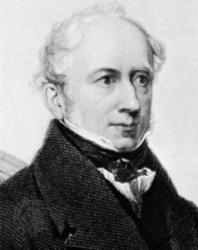- |
User Links
What is the World?
What is the world, a wildering maze
Author: James MontgomeryPublished in 13 hymnals
Representative Text
What is the World?--a wildering maze,
Where sin hath track'd ten thousand ways,
Her victims to ensnare;
All broad, and winding, and aslope,
All tempting with perfidious hope,
All ending in despair.
25
Millions of pilgrims throng those roads,
Bearing their baubles or their loads,
Down to eternal night;
--One only path that never bends,
Narrow, and rough, and steep, ascends
From darkness into light.
Is there no guide to show that path?
The Bible!--He alone who hath
The Bible need not stray;
But He who hath, and will not give
That light of life to all that live,
Himself shall lose the way.
Sacred Poems and Hymns
Author: James Montgomery
 James Montgomery (b. Irvine, Ayrshire, Scotland, 1771; d. Sheffield, Yorkshire, England, 1854), the son of Moravian parents who died on a West Indies mission field while he was in boarding school, Montgomery inherited a strong religious bent, a passion for missions, and an independent mind. He was editor of the Sheffield Iris (1796-1827), a newspaper that sometimes espoused radical causes. Montgomery was imprisoned briefly when he printed a song that celebrated the fall of the Bastille and again when he described a riot in Sheffield that reflected unfavorably on a military commander. He also protested against slavery, the lot of boy chimney sweeps, and lotteries. Associated with Christians of various persuasions, Montgomery supported missio… Go to person page >
James Montgomery (b. Irvine, Ayrshire, Scotland, 1771; d. Sheffield, Yorkshire, England, 1854), the son of Moravian parents who died on a West Indies mission field while he was in boarding school, Montgomery inherited a strong religious bent, a passion for missions, and an independent mind. He was editor of the Sheffield Iris (1796-1827), a newspaper that sometimes espoused radical causes. Montgomery was imprisoned briefly when he printed a song that celebrated the fall of the Bastille and again when he described a riot in Sheffield that reflected unfavorably on a military commander. He also protested against slavery, the lot of boy chimney sweeps, and lotteries. Associated with Christians of various persuasions, Montgomery supported missio… Go to person page >Text Information
| First Line: | What is the world, a wildering maze |
| Title: | What is the World? |
| Author: | James Montgomery |
| Meter: | 8.8.6.8.8.6 |
| Language: | English |
| Copyright: | Public Domain |
Notes
What is the world? a wildering maze. J. Montgomery. [Holy Scripture a Light.] In his Poetical Works 1851, p. 304, Montgomery dates this hymn “1815": but in his newspaper, the Sheffield Iris, of 1817, he printed it in 3 stanzas of 6 lines, and dated it "February, 1817." Under these circumstances it is difficult to say which of these dates is correct. The hymn was repeated in Montgomery's Greenland and Other Poems, 1819, p. 187; his Christian Psalmist, 1825, No. 548; his Poetical Works, 1828, and his Original Hymns, 1853, No. 26. It is also found in Cotterill’s Selection, 1819, and in several of the older and modern hymnbooks. It is not, however, a good example of Montgomery's powers as a writer of hymns.
--John Julian, Dictionary of Hymnology (1907)


 My Starred Hymns
My Starred Hymns

